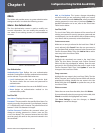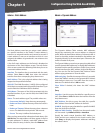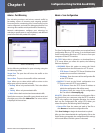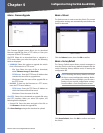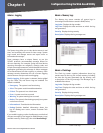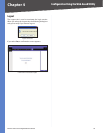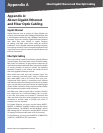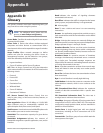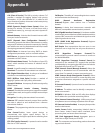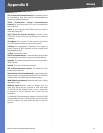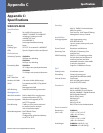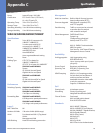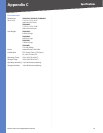
38
Glossary
Business Series Smart Gigabit Ethernet Switch
Appendix B
Appendix B:
Glossary
This glossary contains some basic networking terms you
may come across when using this product.
WEB: For additional terms, please visit the
glossary at www.linksys.com/glossary
Access Mode
Specifies the method by which user access
is granted to the system.
Access Point A device that allows wireless-equipped
computers and other devices to communicate with a
wired network. Also used to expand the range of a wireless
network.
Access Profiles Allows network managers to define
profiles and rules for accessing the device. Access to
management functions can be limited to user groups,
which are defined by the following criteria:
Ingress interfaces
Source IP address and/or Source IP subnets.
ACE Filters in Access Control Lists (ACL) that determine
which network traffic is forwarded. An ACE is based on the
following criteria:
Protocol
Protocol ID
Source Port
Destination Port
Wildcard Mask
Source IP Address
Destination IP Address
ACL (Access Control List) Access Control Lists are
used to grant, deny, or limit access devices, features, or
applications.
Auto-negotiation Allows 10/100 Mbps or 10/100/1000
Mbps Ethernet ports to automatically establish the
optimal duplex mode, flow control, and speed.
Back Pressure A mechanism used with Half Duplex mode
that enables a port not to receive a message.
Bandwidth The transmission capacity of a given device
or network.
Bandwidth Assignments Indicates the amount of
bandwidth assigned to a specific application, user, and/or
interface.
•
•
•
•
•
•
•
•
•
Baud Indicates the number of signaling elements
transmitted each second.
Best Effort Indicates that traffic is assigned to the lowest
priority queue, and packet delivery is not guaranteed.
Bit A binary digit.
Boot To start a device and cause it to start executing
instructions.
Browser An application program that provides a way to
look at and interact with all the information on the World
Wide Web.
Bridge A device that connect two networks. Bridges are
hardware specific, however they are protocol independent.
Bridges operate at Layer 1 and Layer 2 levels.
Broadcast Domain Devices sets that receive broadcast
frames originating from any device within a designated
set. Routers bind Broadcast domains, because routers do
not forward broadcast frames.
Broadcast Storm An excessive amount of broadcast
messages simultaneously transmitted across a network
by a single port. Forwarded message responses are
heaped onto the network, overloading network resources
or causing the network to time out.
Burst A packet transmission at faster than normal rates.
Bursts are limited in time and only occur under specific
conditions.
Burst Size Indicates the burst size transmitted at a faster
than normal rate.
Byte A unit of data that is usually eight bits long
Cable Modem A device that connects a computer to the
cable television network, which in turn connects to the
Internet.
CBS (Committed Burst Size) Indicates the maximum
number of data bits transmitted within a specific time
interval.
CIR (Committed Information Rate) The data rate is
averaged over a minimum time increment.
Class Maps An aspect of Quality of Service system that is
comprised of an IP ACL and/or a MAC ACL. Class maps are
configured to match packet criteria, and are matched to
packets in a first-fit fashion.
Combo Ports A single logical port with two physical
connections, including an RJ-45 connection and a SFP
connection.
Communities Specifies a group of users which retain the
same system access rights.




